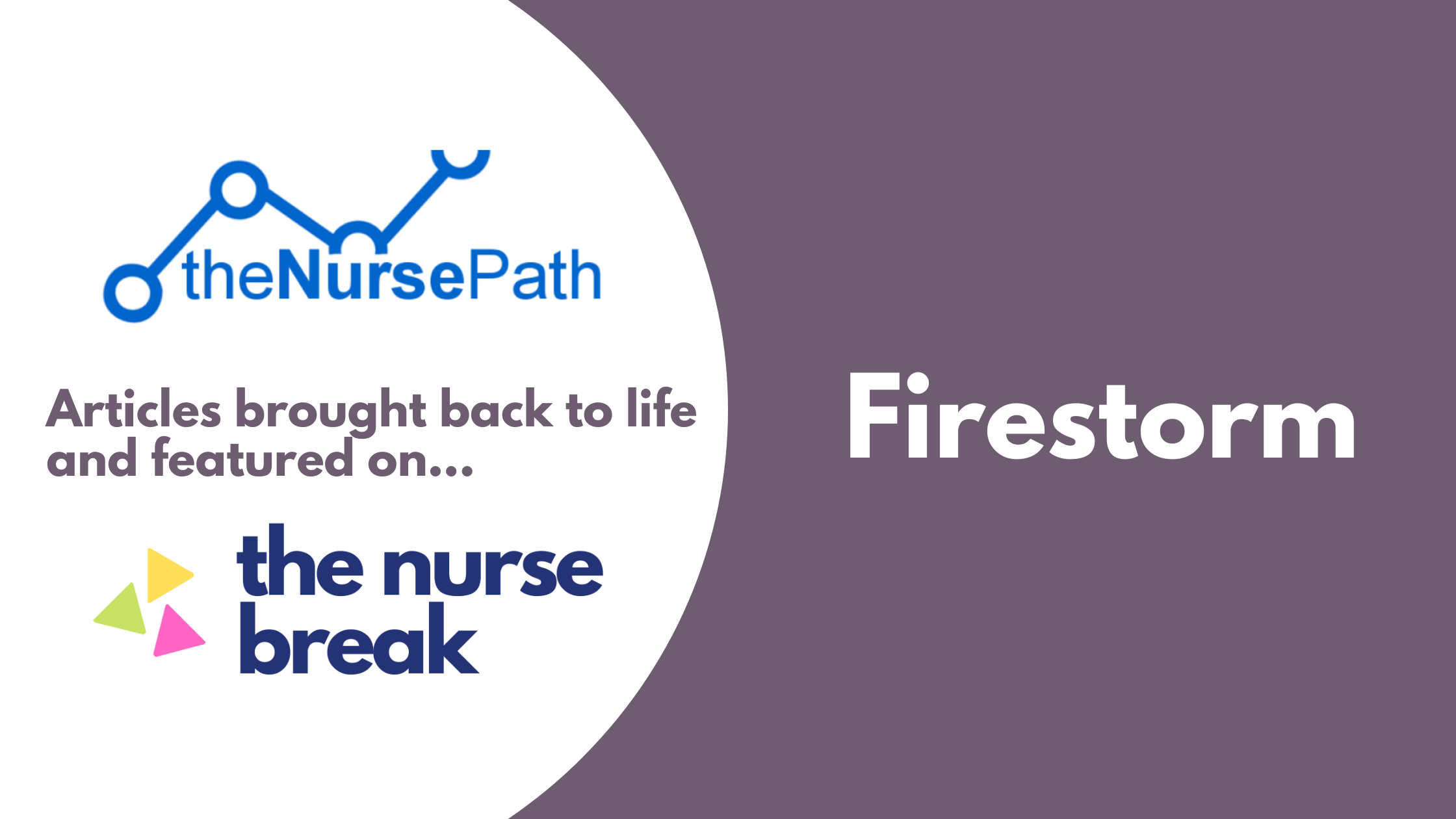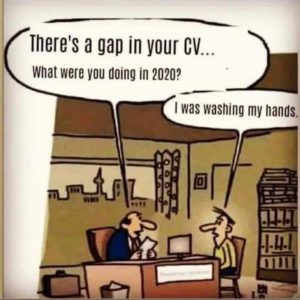Table of Contents
Republished article of The Nurse Path. Find more of The Nurse Path here. Check out our other articles and guest bloggers here. Want to write an article? Go Here
On Saturday 18th January 2003 a freak and devastating firestorm tore through my city.
4 people died and over 500 homes were destroyed.
It resulted in the 2nd largest single hospital disaster response in Australian history.
I was working that day.
2 days later I wrote this story.
———————————————————————–
the firestorm.
It was bloody horribly awesome. Peeking out of the small window in the resuscitation room, it seemed the world had been dipped in a bucket of hell.
Gale force winds whipped at trees beneath a swirling black sky.
Pressing my face against the glass I could see over towards Weston Creek. Dark shapes lit by a dark crimson glow. Even as I watched the glow became an ominous bright orange, white firefly specks spraying up. My sister’s house was down there somewhere.
Just 2 hours previous it had been a relatively peaceful afternoon at work. I had even snuck down to the helipad to take a few pictures of the Southcare helicopter landing.
It was a hot day and the haze of white smoke from a week of distant bushfires hung in the air and covered our cars with a fine layer of talc.
At lunchtime the wind had picked up and the smoke turned from an annoying grey white smudge to a syrupy purple-brown cancer.
Morning staff had just handed over and left for home when the sun went out.
A 1659 hrs a standby Code Brown (hospital disaster response) was activated.
We began calling in extra staff in anticipation of a serious situation developing. This proved difficult as the both the land-line and mobile networks were either over congested or not working. Many of the staff in the department had family and homes in areas that were threatened, and had to make some very difficult decisions. To stay with the ED team or return home. There were no easy answers.
Meanwhile, all the existing patients in the department were transferred to the wards or discharged home in preparation for incoming victims.
The director of the emergency department juggled phones as he tried to ascertain what was going on ‘out there’. As was to be the case throughout the disaster, communication was a real problem, and the only way we had any idea of the magnitude of what was unfolding, was from the paramedics and public that presented.
It has been well documented that during a disaster the bulk (and often, the most critically injured) of patients will arrive by their own means and not by ambulance, and that is exactly what happened.
Cars began arriving and quickly clogged the ambulance bay. At first it was mostly smoke inhalation, asthma attacks and other respiratory related problems. Then falls from ladders and burns to the hands and feet. (The most serious burn patients all arrived by private car)
Shortly after the Code Brown was activated the shit hit the fan. Things began happening so quickly that time seemed to have unraveled into a syrupy slow motion. The almost surreal nature of the situation was enhanced by the thick smoke that had filled the department and the persistent power surges that would stutter us into darkness and then flicker on as the emergency generators cut in and out.
One of the paramedics walked wide-eyed and pale down the corridor.. as he passed, all he said was “I was shit scared out there.”
Tragically, two females with dreadful burns arrived in the back of a ute. They were rushed into the resuscitation room where the trauma team pounced on them.
Another arrived almost simultaneously. She had been in her stationary car when a tornado generated by the firestorm blew it over she was thrown through the window sustaining serious injuries.
A fire-fighter was dragged in semi-conscious and combative from smoke inhalation and severe airway burns…. all he wanted to do was to get back to help his mates.
He wasn’t going anywhere.
Due to the power failure all the fire doors closed making access to other areas of the hospital difficult. Our computer system crashed and we lost power to the radiology department rendering the CAT scan inoperable, and leaving us with only mobile x-ray equipment for some time.
The main disaster control center for the hospital was having major communication problems.
The department quickly filled with a sea of sick, burned and broken people.
Medical teams were crowded around the 3 beds in resus each occupied by a critically ill patient.
Generally, working in the resuscitation room is nothing like you see portrayed on TV. There is no shouting out streams of orders or rushing around dramatically defibrillating folk. Most of the time we all know what needs to be done, and we all get on with it with a calm surgical professionalism.
But tonight there was a noisy, edgy urgency to the room. It was hot and smoky and difficult to breathe. We had no idea what was going to happen next and we were all dreading the arrival of more seriously burned people.
At one stage the backup generators failed, draining the room of the intensive care specialists as they sprinted up to ICU to help ventilate their patients by hand.
I was designated to a team of medical staff caring for a patient with severe burns. This person was conscious and talking when they arrived. Most of her clothes had been burnt away revealing the leathery yellow-white skin of full thickness burns.
She lay there looking up with terrified eyes. So you touch her and you tell her that everything will be OK (and you know that it will not), and you put her to sleep, and you place her on life support, and you all work your butts off to give her the best chance that you can.
I guess the only positive thing you can say about an incident like this is that it brings out the best in people. And a team of amazing people arrived to support and augment the department. From social workers, chaplains and ex-ED staff who turned up to volunteer their services, to patients and relatives who became caregivers themselves.
All were absorbed into the charcoal faced crowd.
Many of the public who presented with ‘minor’ injuries had just lost everything. Many were almost apologetic not wanting to “waste our time”, and sat in small whispering groups or just sat in stunned confusion.
The waiting room was packed full. Nobody complained.
That day we treated over 270 patients 45 of whom were admitted. The next day we would see 198 with 33 admissions.
Not a single member of the department would be untouched by the tragedy. Some lost their houses, many had friends and family who lost everything. My sister’s house had burned to the ground. She escaped with only the clothes she was wearing, and her pets.
At last count over five hundred homes have been counted as completely lost.
However…the following days would prove that the most important things in life are surely non-flammable.
Epilogue:
Sometime after posting this story I received the following reply:
“Those two “seriously burned ladies” were my mother and sister.
ESA couldn’t get ambulances, air evacuation or foot soldiers in to get them out of that equestrian centre, where “the air was on fire”.
By some spear of fate, at the equestrian centre there was an ex-nurse who drove them in in the back of her vehicle (the ute in question), understanding the severity of their injuries at that initial moment.
She had somehow had the wherewithal to fill up bottles of water which she gave to them, instructing them to “sip, pour it over yourselves, and keep talking to me…” as she drove them to the emergency room at Canberra Hospital.
They walked into the emergency room. I know this only because I saw footage on ABC a few weeks later: some shaky, phone-filmed memory. I saw my sister walking from behind, t-shirt gone, hair matted, skin bubbled yellow and black, teetering in that unsteady, shock-ridden gait. She would not walk again for several months.
I didn’t see them on their initial admission into Canberra hospital. I saw them 24 hours later – after they were flown to Sydney where they would stay in Concord Hospital, for the year-long hospitalisation that began the exhaustive and emotionally wrenching road ‘home’.
I can only imagine what kind of mettle it takes to be nurse. I saw more horror in that year than I ever imagined I would or should.
That first moment I saw them after the initial injury still haunts me. Blistered, skin surgically and strategically sliced to prevent rupturing from the intense swelling from the body’s reaction to burns. Half bandaged, stinking of salt, sweat, antiseptic and scorched flesh.
My 20-year old sister and my mother had become two great swollen mounds of fluid and dressings and blistered flesh, unrecognisable except only by their teeth and nostrils.
Irreconcilable with the image of the people I knew and loved.
Somehow, the four of us (mother, sister, father and I) made it here, to January 18th, 2013.
Anything I say couldn’t possibly express the gratitude I owe to the people who helped us on that black day in 2003, and the tumultuous years following.
I was myself hospitalised some years after with my own various mental health issues (not in the least, PTSD related to the events of 2003).
So I suppose a great deal of my thanks goes to those numerous nurses. Who have been with us at so many points along the way, even from those first critical minutes. Those teeth-gritting, tear-jerking, stubbornly good-to-the-bone nurses.
They are the people who give care even when the giving seems cruel.
I can’t thank you enough, as it’s quite likely you held my sister or my mother in your hands that day.”





